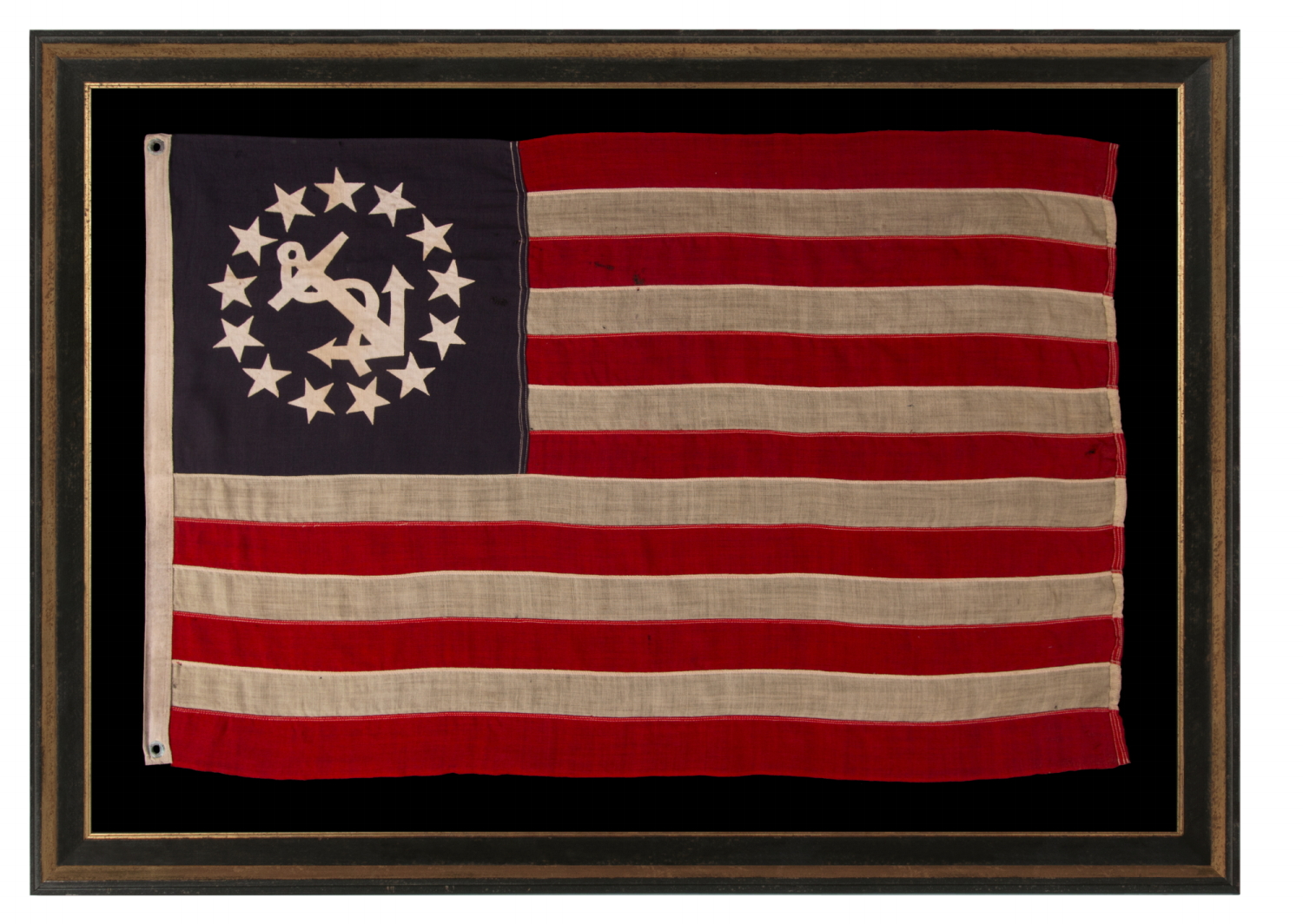


| ANTIQUE AMERICAN PRIVATE YACHT FLAG / ENSIGN WITH 13 STARS AND A CANTED ANCHOR, circa 1895 – 1940 |
|
| Web ID: | 13j-1734 |
| Available: | In Stock |
| Frame Size (H x L): | Approx. 43" x 59" |
| Flag Size (H x L): | 31.5" x 47.5" |
| Description: | |
| The medallion configuration, 13-star, 13-stripe flag, with a canted center anchor was adopted in 1848, following an act of Congress that made it the official signal for U.S. pleasure sailing vessels. The need for such a signal arose with the popularity of boating as a pastime for well-to-do Americans, and as a competitive sport, in addition to its longstanding utilitarian role as a vehicle of trade. In early America, all boats were subject to customs searches at every port. Without modern income tax, the federal government derived its revenues mostly from tariffs, so the accounting of foreign goods on ships was a critical venture. As yachting for pleasure became more prevalent, however, more and more time was spent searching boats that had no such inventory, wasting time for both customs officials and wealthy ship owners. John Cox Stevens (1775 - 1857), one of the most important members of New York society, was responsible for bringing the private yacht flag to fruition. Stevens was the paternal grandson of John Stevens, Jr., New Jersey delegate to the Second Continental Congress, and son of Revolutionary War officer, Colonel John Stevens, who pioneered the development of steamboats and purchased what would eventually become the City of Hoboken. Among other ventures, John Cox Stevens served as president of the Jockey Club (United Kingdom), was a founding member and 2nd president of New York's Union Club (est. 1836), and founding Commandant of the New York Yacht Club (elected 1844/est. 1845). He was part of the syndicate that own the yacht "America," which, in 1851, won the trophy that would eventually be named in its honor, the America's Cup. In 1847, Stevens approached the secretary of the treasury and suggested that something be done to streamline the customs process for non-trade vessels. In 1848, legislation passed Congress requiring registration of these boats, which could then fly the “American Yachting Signal” to bypass customs. This remained on the books until the 1980’s. Though the 1848 legislation was revoked, use of flags in this design, flown for decorative function, continues to this day. Made sometime between roughly 1895 and 1940, the stars and anchor of this particular example are made of cotton and are double-appliquéd (applied to both sides) with a zigzag, machine stitch. The canton and the stripes of the flag are made of wool bunting that has been pieced and joined by machine stitching. Note how the profile of the canton is near to square and actually a bit taller than it is wide, which gives the flag a more interesting appearance and is graphically pleasing. There is a twill cotton binding along the hoist, applied in the same manner, with two brass grommets. This is a commercially made flag. Like many of its counterparts of the period, it is unmarked with any sort of maker’s name or label. Few makers signed their flags during this period or prior. Though construction changed very little, for the most part, between the second half of the 1890’s and the mid-20th century, it can be difficult to accurately place one at 1900 vs. 1920, vs. 1940. That is the case here, though instinct, having owned thousands of antique flags, tells me that this particular example is very likely 1920’s or prior. 13 star flags have been flown throughout our nation’s history for a variety of purposes. In addition to their use on private yachts, they were hoisted at patriotic events, including Lafayette’s final visit in 1824-25, the celebration of the nation’s centennial in 1876, and the sesquicentennial in 1926. They were displayed during the Civil War, to reference past struggles for American liberty, and were used by 19th century politicians while campaigning for the same reason. The U.S. Navy used the 13 star count on small boats until 1916, because it was easier to discern fewer stars at a distance on a small flag. Commercial flag-makers mirrored this practice and some private ships flew 13 star flags during the same period as the Navy. Mounting: For 25 years we have maintained a specialized department for this purpose. We take great care in the mounting and preservation of flags and related textiles and have framed thousands of examples. The background fabric is 100% cotton twill, black in color, that has been washed and treated for colorfastness. The black-painted, hand-gilded and distressed molding is Italian. The glazing is U.V. protective acrylic (Plexiglas). Feel free to contact us for more details. Condition: There is minor to modest fabric loss in limited areas, in both the canton and the striped field. There us minor to modest soiling in the white cotton fabrics. The grommets are encrusted with green verdigris. Many of my clients prefer early flags to show their age and history of use. |
|
| Video: | |
| Collector Level: | Beginners and Holiday Gift Giving |
| Flag Type: | Sewn flag |
| Star Count: | 13 |
| Earliest Date of Origin: | 1895 |
| Latest Date of Origin: | 1940 |
| State/Affiliation: | 13 Original Colonies |
| War Association: | |
| Price: | Please call (717) 676-0545 or (717) 502-1281 |
| E-mail: | info@jeffbridgman.com |
 |
|